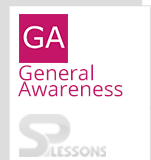 Introduction
Introduction
General Awareness is an important component of most of the competitive exams for employment in the government sector in India. The article IBPS RRB PO General Awareness Quiz 20 presents questions related to IBPS PO, SSC CGL, SSC MTS, SSC CHSL, SEBI Grade A, Indian Bank PGDBF PO, LIC HFL, NIACL Assistant, RRB Assistant, RRB PO, SBI Clerk, SBI PO, RBI Grade B and BOB PGDBF PO. The article IBPS RRB PO General Awareness Quiz 21 have been designed keeping in view the significant role of General Awareness sections in the scoring of competitive exams. IBPS RRB PO General Awareness Quiz 21 is very useful to crack the General Awareness sections of several competitive exams.
 Pattern
Pattern
IBPS RRB PO General Awareness Quiz 21 - Exam Pattern
* Candidates can opt either 4 a or 4 b
The IBPS RRB PO General Awareness section in the Main Exam, has a total of 40 questions. Below mentioned are the different categories of expected questions in the Main Exam of IBPS RRB Group B General Awareness.
| S. No. | (Objective) Test Name | Medium of Exam | Questions | Marks | Duration |
|---|---|---|---|---|---|
| 1 | Reasoning Ability | Hindi/English | 40 | 50 | 2 hours |
| 2 | Numerical Ability | Hindi/English | 40 | 50 | |
| 3 | General Awareness | Hindi/English | 40 | 40 | |
| 4 a* | English Language | English | 40 | 40 | |
| 4 b* | Hindi Language(हिंदी) | Hindi | 40 | 40 | |
| 5 | Computer Knowledge | Hindi/English | 40 | 20 | |
| Total | 200 | 200 | |||
 Syllabus
Syllabus
IBPS RRB PO General Awareness Quiz 21 - Exam Syllabus
| S. No. | Name of the Topic |
|---|---|
| 1. | Indian Economy |
| 2. | Laws |
| 3. | Government schemes |
| 4. | General Science |
| 5. | 5-year plans |
| 6. | Books with Authors |
| 7. | Indian Constitution |
| 8. | Indian history |
| 9. | Geography |
| 10. | Countries and currencies |
| 11. | Award |
| 12. | Data Interpretation |
| 13. | Sports |
| 14. | Budget and taxes |
| 15. | Indian Banking Industry |
| 16. | RBI and Monetary Policy |
| 17. | Money Market in India |
| 18. | Capital Market in India |
| 19. | Public Finance |
| 20. | National Income |
 Quiz
Quiz
1. Commercial banking system in India is
-
A. Cotton Textile
B. Iron & Steel
C. Jute
D. Paper
-
A. First Five Year Plan
B. Third Plan
C. Fourth Plan
D. Second Plan
-
A. Public Sector
B. Socialist Goal
C. Agricultural Development
D. Governmental Involvement
-
A. Private consumption
B. Public consumption
C. Export
D. Public and private consumption
-
A. Using green manure
B. Raising more crops
C. High-yielding variety program
D. Green vegetation
1. “Poverty Line” means
-
A. The line of demarcation between the rich and the poor
B. The lowest level in the ladder of economic prosperity
C. The state at which there is a leveling down between the rich and the poor
D. The minimum level of per capita consumer expenditure
-
A. The Prime Minister
B. Governor, RBI
C. The President
D. Chairman, NABARD
-
A. Customs
B. Excise Duty
C. Sales Tax
D. All of the Above
-
A. Hospitals
B. Schools
C. Railways
D. Offices
-
A. Electronics
B. Iron and Steel
C. Textiles
D. Sugar
1. At the time of enactment of the Constitution which on of the following ideas was not included in the preamble ?
-
A. Justice
B. Socialist
C. Liberty
D. Equality
-
A. The parliament
B. The Speaker of Lok Sabha
C. The Comptroller and Auditor General
D. The president
-
A. Right to Constitutional Remedies
B. Right against Exploitation
C. Right of Equality
D. Right of Religion
-
A. Right against exploitation
B. Equality before law
C. Right to freedom to religion
D. Equal pay for equal work
-
A. parliamentary system.
B. presidential system
C. Quasi - presidential system
D. plural executive system



